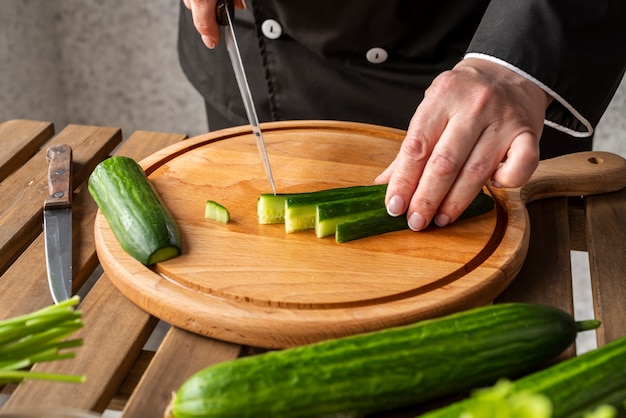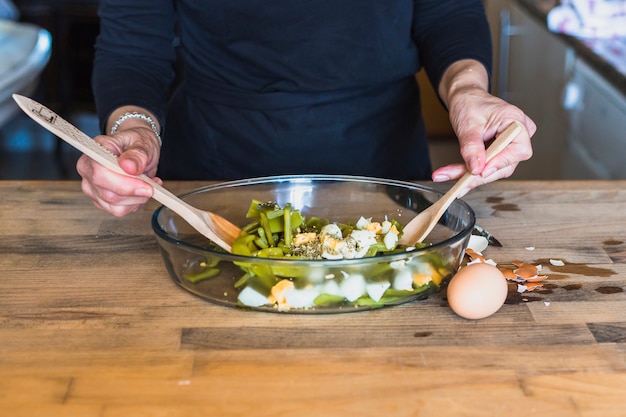Spring is in the air, and with it comes the tantalising scent of wild ramps. These garlicky, oniony, and undeniably delicious plants are a true treasure of the season. For a short but glorious window, you can find them tucked away in the woods, their emerald green leaves a welcome sight after a long winter. As a seasoned ramp enthusiast, I'm absolutely smitten with these wild gems. I love their earthy, pungent flavour, their vibrant green colour, and how they herald the arrival of warmer days. But I understand that wild ramps can seem daunting to many cooks. Where can you find them? How do you know they're safe to eat? And what culinary wonders await once you've got them home?
Fear not, my friends! I'm here to guide you through the wild world of ramps, sharing my personal experiences, tips, and tricks. We'll uncover the secrets of identifying, harvesting, preparing, and cooking these springtime treats. I'll be your ramp whisperer, your culinary compass, your personal cheerleader as you embark on this delicious adventure. So, grab your favourite mug, brew yourself a cup of tea, and let's get rampin'!
(Part 1) Ramps: A Springtime Treasure

The Allure of Ramps
Ramps, also known as wild leeks, are a perennial herb that thrives in the wild, usually in the cool, shady haven of woodlands. They're part of the allium family, which means they're closely related to onions, garlic, and shallots. That explains their distinctive, garlicky, oniony flavour that many adore. But ramps have an extra layer of complexity - an earthy, almost pungent note that sets them apart. It's a flavour that's both familiar and unique, captivating those who dare to taste it.
You might be thinking, "These sound like something you'd find in a garden, not in the woods." But trust me, ramps are wild and free. You won't find them at your local supermarket; you'll need to venture into nature to discover their hidden bounty. They're a true symbol of spring, emerging from the undergrowth as the first wildflowers begin to bloom. It's that wildness that makes them so special. They're a taste of nature, a reminder of the changing seasons, a rare and fleeting treat.
Ramps and Sustainability
Now, before we get too carried away with the excitement of ramp season, it's important to talk about sustainability. Ramps are a delicate plant, and their populations can be easily depleted if we're not mindful. It's not about hoarding or overharvesting; it's about respecting the delicate balance of nature.
Think about it this way: you wouldn't just go into someone's garden and take everything, would you? The same principle applies to wild ramps. When harvesting, take only what you need, and always leave some plants behind to ensure future generations can enjoy them. Leave the smaller ramps to grow, don't pull them up by the roots, and choose a healthy population where the plants are plentiful. If you're unsure about responsible harvesting, reach out to local foraging groups or experts. They can guide you to sustainable sources and ensure you're harvesting in a way that benefits both you and the environment. Remember, our responsibility is to enjoy these plants while ensuring their continued presence in our ecosystems.
(Part 2) Identifying Ramps: The Dos and Don'ts

The Ramp Whisperer's Guide
Learning to identify ramps is crucial for enjoying them safely. You've got to know your ramps from your other wild edibles, right? It's not just about finding them; it's about finding them safely. This is where my years of experience come in. I'll share my wisdom so you can confidently identify these tasty treasures.
Key Features of a Ramp
- The Leaves: Ramps have long, slender leaves, typically a deep emerald green. They're often described as sword-shaped or lance-shaped, with a smooth, slightly glossy surface.
- The Bulbs: The bulb, the part we eat, is nestled beneath the leaves. It's small, white, and elongated, with a slightly pointed tip. It gives off a distinct garlic-like scent but has a more earthy flavour.
- The Smell: Ramps have a pungent aroma, a blend of garlic and onion, but with a wild, earthy twist. If you're unsure, gently brush your fingers against the leaves and take a whiff. It's an aroma that's hard to forget.
What to Look Out For
It's important to be aware of plants that can be mistaken for ramps, as some can be poisonous. Here are key differences to help you avoid the look-alikes:
- Lily of the Valley: This plant has a bell-shaped flower and much broader leaves than ramps. Lily of the valley is poisonous, so it's crucial to avoid it.
- False Hellebore: Another toxic plant that can be mistaken for ramps. False hellebore has leaves that are more rounded and less pointed than those of ramps. It also has a reddish tinge at the base of the leaf.
- Trillium: This plant has three leaves that grow directly from the ground. Trillium is not poisonous, but it's not a ramp either! Look for the long, slender leaves of ramps, not the three broader leaves of trillium.
Remember: If You’re Unsure, Don't Eat It
I can't emphasize this enough: If you're even the slightest bit unsure about a plant, don't eat it. There are many resources available to help you learn to identify ramps. Get in touch with your local foraging group, look up online resources, or even take a course from an experienced forager. It's better to be safe than sorry. Your taste buds will thank you!
(Part 3) Harvesting Ramps: A Sustainable Approach

Respect the Land
You've learned to identify those prized ramps, now it's time to talk about harvesting them responsibly. It's not just about picking a few leaves; it's about ensuring that these wild plants thrive for years to come. I’m talking about respecting the ecosystem and ensuring future generations can enjoy the bounty of ramps.
The Right Way to Harvest Ramps
- Choose a Mature Plant: When harvesting ramps, only pick the larger plants. Leave the smaller plants alone so they can continue to grow and reproduce.
- Don’t Pull the Bulbs: Instead of pulling them up by the roots, use a sharp knife to cut the bulb just below the soil level. This allows the plant to regenerate.
- Be Mindful of Your Impact: Choose a patch that has a healthy population of ramps, ensuring that you’re not taking too many plants from one area. It’s all about sustainability.
- Spread the Love: Don’t be afraid to share your foraging knowledge. If you see someone who is harvesting ramps in a way that could harm the plants, offer some friendly advice. The goal is to spread awareness about sustainable harvesting.
What to Do with Your Harvest
Once you've got your ramps, it’s time to clean them. First, wash them gently in cold water to remove any dirt or debris. If you’re planning to use the bulbs, be sure to trim the roots and the green tops. You can store your harvested ramps in a plastic bag in the refrigerator, but they’ll only keep for a few days. So, get ready to cook!
(Part 4) Preparing Ramps: From Forest Floor to Your Plate
Simple Cleaning and Storage
You've got your ramps, and you’re ready to get cooking. But hold on! Before you get carried away with all the culinary possibilities, there are a few important steps to ensure your ramps are ready for your kitchen.
Cleaning Ramps: The Gentle Approach
Ramps, like any other wild food, can be a little bit gritty. So, the first thing you need to do is give them a good wash. But be gentle! Rough handling can bruise the leaves and affect their delicate flavour. Here’s my preferred method:
- First Rinse: Fill a bowl with cold water and gently swish your ramps around to remove any loose dirt.
- Second Rinse: Repeat the process with a fresh bowl of water, making sure to remove all remaining dirt or debris.
- Pat Them Dry: Pat the ramps dry with a clean kitchen towel. They should be ready to be chopped, sautéed, or used in your favourite recipe.
Storing Ramps: Keeping Them Fresh
Ramps are a seasonal treat, and they won’t last forever. Once you've cleaned them, you need to store them properly. Here’s my tried-and-true method:
- Wrap Them Up: Place the cleaned ramps in a plastic bag, making sure to remove as much air as possible. The bag will help keep the ramps moist and fresh.
- Chill Out: Store the bag in your refrigerator’s crisper drawer. The cool environment will help keep the ramps from spoiling.
- Don’t Delay: Ramps will start to wilt and lose their flavor after a few days. Use them as soon as possible!
(Part 5) Ramp Recipes: Bringing the Wild Flavour Home
A culinary adventure
Now, the moment you’ve all been waiting for. Time to talk recipes! I'm not talking about your boring, bland, everyday cooking here. We’re going wild! We’re talking about infusing your dishes with the unique, earthy, garlicky, and oh-so-delicious flavour of ramps. Get ready for a culinary adventure!
Ramp Recipes for Every Taste
From simple to sophisticated, there’s a ramp recipe out there for everyone. I’ll share some of my favourites, ones that I’ve perfected over the years, ones that will make your taste buds sing with joy!
| Recipe | Description |
|---|---|
| Ramp Pesto | A classic flavour combination with a vibrant green hue. It's perfect for topping pasta, sandwiches, or even eggs. |
| Ramp Soup | A comforting and flavourful soup that’s perfect for a chilly spring evening. |
| Ramp and Goat Cheese Quiche | A delicate and elegant quiche that's perfect for a special occasion. |
| Ramp and Mushroom Pizza | A wood-fired pizza with a smoky, earthy flavour. |
| Ramp and asparagus pasta | A simple pasta dish that showcases the fresh flavours of spring. |
| Ramp Salsa | A vibrant and spicy salsa that’s perfect for topping tacos, nachos, or even fish. |
Simple Ramp Dishes: A Taste of Spring
Don't be afraid to get creative and experiment with ramps. Here are a few ideas for simple dishes that will showcase the unique flavour of ramps:
- Ramp-infused Olive Oil: This is a versatile ingredient that you can use to add a touch of ramp flavour to salads, pasta dishes, or even grilled meats.
- Ramp Butter: A decadent and delicious way to enjoy ramps. It’s perfect for spreading on toast, grilled bread, or even a simple steak.
- Ramp and Egg Scramble: A quick and easy breakfast dish that’s full of flavour.
- Ramp and potato salad: A classic side dish with a wild twist.
(Part 6) Ramp-infused Olive Oil: A Versatile Ingredient
Adding a Touch of Wildness
If you’re looking for a simple way to infuse your dishes with the unique flavour of ramps, then you’ve got to try ramp-infused olive oil. It’s a versatile ingredient that you can add to salads, pasta dishes, grilled meats, or even use as a finishing touch on soups and stews. Plus, it’s incredibly easy to make.
Making Your Own Ramp-infused Olive Oil
Here’s what you need:
- Fresh Ramps: Use about 1/2 cup of chopped ramps.
- extra virgin olive oil: Choose a high-quality olive oil that you enjoy.
- Sterilized Jars: You’ll need glass jars with tight-fitting lids.
Instructions
- Clean and Chop: Wash the ramps thoroughly and pat them dry. Chop them into small pieces.
- Pack the Jars: Fill the sterilized jars with the chopped ramps, leaving about an inch of space at the top.
- Pour the Oil: Pour the olive oil over the ramps, making sure to cover them completely.
- Seal and Steep: Seal the jars tightly and place them in a cool, dark place. Let the oil steep for at least 2 weeks, but it can be left for up to 6 weeks for a more intense flavour.
- Strain and Store: After steeping, strain the oil through cheesecloth or a fine-mesh sieve. Discard the ramps and store the oil in a tightly sealed container in a cool, dark place.
Using Ramp-infused Olive Oil
Now that you’ve got your ramp-infused olive oil, it’s time to experiment! Here are a few ideas:
- Drizzle over salads: Add a touch of spring flavour to your salads by drizzling with ramp-infused olive oil.
- Finish soups and stews: Add a few drops of ramp-infused olive oil to your favourite soups and stews for a flavour boost.
- Marinate grilled meats: Use ramp-infused olive oil to marinate grilled chicken, fish, or steak.
- Add to pasta dishes: Toss your favourite pasta dish with ramp-infused olive oil for a flavour explosion.
- Make a dip: Combine ramp-infused olive oil with a little goat cheese, chopped herbs, and a squeeze of lemon for a delicious dip.
(Part 7) Ramp and Goat Cheese Quiche: An Elegant Treat
A Taste of Spring in Every Bite
Okay, let's get fancy! We’re going to whip up a ramp and goat cheese quiche. It’s a delicate and elegant dish that’s perfect for a special occasion. Plus, it’s incredibly easy to make. You’ll be surprised by how simple it is to achieve such a delicious and impressive result.
Ingredients
- Pie Crust: One pre-made pie crust (or make your own if you’re feeling ambitious)
- Ramps: About 1/2 cup of chopped ramps
- Goat Cheese: About 8 ounces of crumbled goat cheese
- Eggs: 4 large eggs
- Milk: 1 cup of milk
- Salt and Pepper: To taste
- Optional: Fresh Herbs: A handful of fresh herbs, like thyme or chives
Instructions
- Preheat the Oven: Preheat your oven to 375 degrees Fahrenheit.
- Prepare the Crust: Line a pie plate with the pie crust. Prick the bottom with a fork and blind bake for 10 minutes.
- Sauté the Ramps: In a skillet, heat a tablespoon of olive oil over medium heat. Add the chopped ramps and sauté for about 5 minutes, or until they are softened.
- Combine the Ingredients: In a large bowl, whisk together the eggs, milk, salt, and pepper. Add the sautéed ramps and crumbled goat cheese, and mix well.
- Fill the Crust: Pour the egg mixture into the pre-baked pie crust. Sprinkle with fresh herbs, if desired.
- Bake: Bake the quiche for 30-35 minutes, or until the center is set.
- Cool and Serve: Let the quiche cool slightly before slicing and serving.
Tips for Quiche Perfection
- Blind-baking: blind baking the crust helps ensure a crisp, flaky crust.
- Don’t overcook: Overbaking the quiche can result in a dry and rubbery texture. Check the center with a toothpick. It should come out clean.
- Serve warm: The quiche is best served warm, but it can also be enjoyed at room temperature.
(Part 8) FAQs: Your Ramp Questions Answered
Q1: Where can I find ramps?
Ramps grow wild, typically in shady woodlands, but their exact locations can vary depending on your region. A good place to start is by asking local foragers or checking online resources, such as foraging communities or local nature organizations. These groups can often provide information on safe and sustainable foraging spots.
Q2: When is ramp season?
Ramp season is typically short and sweet, lasting only a few weeks in the spring. It usually starts in late March or early April and lasts until the end of May. However, this can vary depending on your location and the weather.
Q3: How long do ramps last?
Fresh ramps will last for a few days in the refrigerator if they are properly stored. They should be wrapped in a plastic bag and placed in the crisper drawer.
Q4: Can you freeze ramps?
Yes, you can freeze ramps. To freeze them, blanch them in boiling water for 1 minute, then immediately plunge them into ice water to stop the cooking process. Drain well and spread out in a single layer on a baking sheet to freeze. Once frozen, transfer them to a freezer-safe bag or container. Frozen ramps can be used in recipes like soups, stews, or sauces.
Q5: What are some other things I can do with ramps?
Ramps are a versatile ingredient that can be used in a variety of dishes. Besides the recipes mentioned above, you can also use ramps to:
- Make a ramp sauce: Combine chopped ramps, butter, and a little cream for a delicious sauce that’s perfect for pasta, grilled chicken, or fish.
- Add to a stir-fry: Ramps add a unique flavour to stir-fries, especially when paired with tofu, chicken, or shrimp.
- Make a ramp dip: Combine chopped ramps, cream cheese, sour cream, and a little garlic for a delicious dip that’s perfect for crackers, vegetables, or chips.
- Add to a salad: Toss ramps into your salads for a flavour boost and a touch of green.
Everyone is watching

Prime Rib Roast Cooking Time Chart: Per Pound Guide
Cooking TipsPrime rib roast. Just the name conjures images of lavish dinners, crackling fires, and hearty laughter. It’s ...

How Long to Bake Potatoes in the Oven (Perfect Every Time)
Cooking TipsBaked potatoes are a staple in my kitchen. They're incredibly versatile, delicious, and surprisingly easy to m...

Perfect Rice Every Time: The Ultimate Guide to Cooking Rice
Cooking TipsAs a self-proclaimed foodie, I've always been a bit obsessed with rice. It's the foundation of countless cuisi...

The Ultimate Guide to Cooking Asparagus: Tips, Techniques, and Recipes
Cooking TipsAsparagus. The mere mention of this spring delicacy conjures up images of vibrant green spears, crisp and burs...

Ultimate Guide to Cooking the Perfect Thanksgiving Turkey
Cooking TipsThanksgiving. Just the word conjures up images of overflowing tables laden with delicious food, the scent of r...
